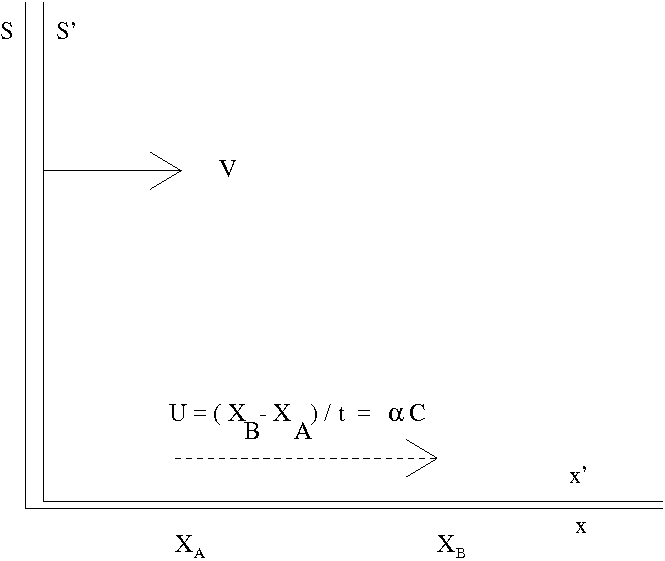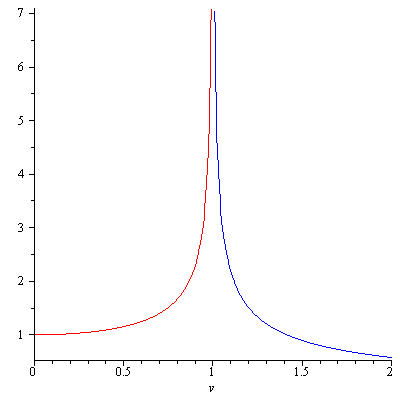In this note, we obtain the energy-momentum relation \begin{equation}\label{eq:e-m2}E^2=p^2c^2+m_0c^4\end{equation} which was first introduced by P.A.M. Dirac. Before we get to that, let us study some basic quantities of mechanics in special relativity. Suppose the world vector $\vec{r}=(ct,x,y,z)$ is timelike. Then $$dr^2=-c^2dt^2+dx^2+dy^2+dz^2<0$$ Define $d\tau:=\sqrt{-\frac{dr^2}{c^2}}$. Then \begin{equation}\label{eq:proptime}d\tau=\sqrt{1-\frac{v^2}{c^2}}dt\end{equation} $d\tau$ is the actual time measured by the clock in the moving system at the speed $v$. At rest ($v=0$), $d\tau$ coincides with the coordinate time $dt$. $d\tau$ is called the proper time of the moving frame. The derivative of the world vector $\vec{r}=(ct,x,y,z)$ with respect to the proper time $\tau$ is called the four-velocity $$\vec{v}=\frac{d\vec{r}}{d\tau}=\left(c\frac{dt}{d\tau},\frac{dx}{d\tau},\frac{dy}{d\tau},\frac{dz}{d\tau}\right)$$ Using \eqref{eq:proptime}, the four-velocity can be written as \begin{equation}\label{eq:4-velocity}\vec{v}=\frac{1}{\sqrt{1-\frac{v^2}{c^2}}}(c,{\bf v})\end{equation} where ${\bf v}=\left(\frac{dx}{dt},\frac{dy}{dt},\frac{dz}{dt}\right)$. $$\vec{v}\cdot\vec{v}=\frac{1}{1-\frac{v^2}{c^2}}(-c^2+v^2)=-c^2$$ The four-momentum $\vec{p}$, as a natural generalization of the Newtonian momentum, is defined by \begin{equation}\label{eq:4-momentum}\vec{p}:=m_0\vec{v}=\frac{m_0}{\sqrt{1-\frac{v^2}{c^2}}}(c,{\bf v})\end{equation} $$\vec{p}\cdot\vec{p}=-m_0^2c^2$$ On the other hand, $\vec{p}$ also can be written as \begin{equation}\label{eq:4-momentum2}\vec{p}=(mc,m{\bf v})=\left(\frac{E}{c},{\bf p}\right)\end{equation} where $m=\frac{m_0}{\sqrt{1-\frac{v^2}{c^2}}}$ and ${\bf p}=(p_x,p_y,p_z)$.
Remark. It is customary in physics literature to write the world vector as $(ict,x,y,z)$ while keeping the metric of spacetime in the appearance of Euclidean metric as seen in [1]. Likewise, the four-momentum is written as $\vec{p}=\left(i\frac{E}{c},{\bf p}\right)$. I am a geometer, not a physicist and I don’t personally like such convention so I am not using it.
Now, from \eqref{eq:4-momentum} and \eqref{eq:4-momentum2}, we obtain the energy-momentum relation \eqref{eq:e-m2}. At rest (${\bf p}=0$), we retrieve Einstein’s famous mass-energy equivalence $E=m_0c^2$. The energy-momentum relation \eqref{eq:e-m2} leads to two very important equations in relativistic quantum mechanics, the Klein-Gordon equation for charged spin-0 particles and the Dirac equation for spin-1/2 fermions [2].
Analogous to the Newtonian force, the four-force is defined by $$\vec{F}=\frac{d\vec{p}}{d\tau}=\frac{1}{\sqrt{1-\frac{v^2}{c^2}}}\frac{d\vec{p}}{dt}$$
Food for thought: For a tachyon, the energy-momentum relation is given by $$E^2=p^2c^2-m_0^2c^4$$ as its rest mass is purely imaginary. Can we obtain a physically sound equation for tachyons from this energy-momentum relation?
References:
[1] Walter Greiner, Classical Mechanics, Point Particles and Relativity, Spinger-Verlag, 2004
[2] Walter Greiner, Relativistic Quantum Mechanics, 3rd Edition, Springer-Verlag, 2000

 Now suppose the signal travels at a speed exceeding $c$, that is $\alpha > 1$. Let us calculate the elapsed time as measured by a frame going by at speed $V<c$. According to the Lorentz transformation,
Now suppose the signal travels at a speed exceeding $c$, that is $\alpha > 1$. Let us calculate the elapsed time as measured by a frame going by at speed $V<c$. According to the Lorentz transformation,

